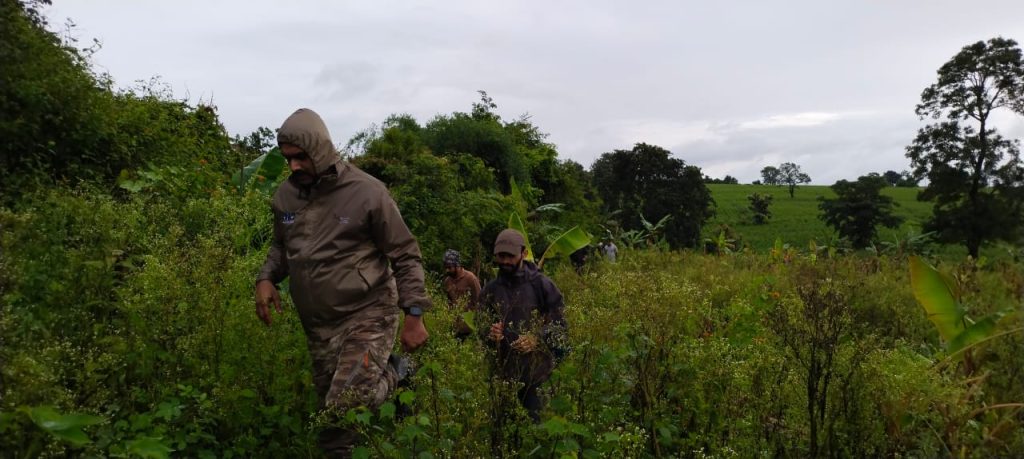The “Shocking” Truth Bordering Farmlands in Karnataka
Something is calming about walking in the forest, especially when you walk with a sense of purpose. The gentle crush of twigs beneath your feet, the beautiful forest sounds emanating from the tiniest insect to the busy birds, and the strange silence that encompasses you as you walk undulating terrains to look for the silent killers – snares!
Anti-Snare Walks (ASW) has been instrumental in detecting these snares and dismantling them, and with the recent mandate of the National Tiger Conservation Authority (NTCA), the emphasis on such walks has only been strengthened. WTI has pioneered the ASW efforts across the country, perambulating sensitive forest fringes and snaring hotspots of Uttar Pradesh, Bihar, Madhya Pradesh, Chhattisgarh, Maharashtra, Karnataka and Assam, to protect the forests from snares and other hunting tools.

Anti snare walk in Nagarhole NP | Photo by Mahima Sharma
Do not allow the word “walk” to mislead you, for it is anything like a normal walk or stroll in a park. There is a hop, skip and jump at every turn and what lies beyond the bushes is best left there. The path of the forest is highly uneven and no amount of trained shoes can ever prepare you for the sheer exhaustion that these walks bring. Lest we forget, there are always insects, leeches and other inhabitants of the forests that will disapprove your entry in different ways such as latching on to the tiniest space of your skin – or worse, entering into your shirts or pants!
More recently, WTI’s Wildlife Crime Control Division, Karnataka Forest Department and State Tiger Protection Force, conducted an ASW in the Nagarhole Tiger Reserve. The trained eyes of the team scanned every branch, fence and wire that they came across, often even delving straight into deep trenches to ensure that the zone is snare-free. The STPF staff and WTI team members did not hesitate to trudge down these trenches, battling sharp branches and thorny logs in order to check the area for snares. It is very important to note that the people installing snares are fluent in studying hoof marks and pug marks. They know exactly where to extend the electric line and manipulate the voltage illegally so as to target these animals in order to deter them from entering the farmlands.

Checking for snares | Photo by Mahima Sharma
However, our 6km walk came to a screeching halt when we saw a huge farm, ripe with harvest and bordered by an electric fence. In any other circumstances, one could take the liberty to assume that it is just a harmless wire to protect the farmland from any intrusion but as we followed the wire, it was connected to an electric board which was then connected to a live power station. Needless to mention, the intention was to target the animals and electrocute them, even if it was just to deliver a mild “deterrence”, the unregulated electric shock will lead to instant death. The scene that presented itself in front of us was essentially that of a blatant disregard for the law, the wildlife and the forest with the clear intention that it was set to electrocute any animal that would come in contact with it.
The electric wire was placed at such a height that it would be evident for any human to jump over it but for any animal to easily fall prey to it as soon as they would come in contact with it. There were bamboo sticks that were placed every few metres to provide insulation to the electric charge when the current would run. Upon closer observation, the team observed burn marks along the wire which is caused due to high electric charge running through the wire.
Agricultural farmers set such electric wires along the farmland boundary to protect their crops from crop-raiding animals such as wild pig, spotted deer, bonnet macaques, etc, but more often than not, larger mammals such as leopards, elephants, and tigers fall prey to such high voltage fences. Official statistics released by the Ministry of Environment, Forests and Climate Change (MoEFCC) states that as many as 600 elephants have lost their lives to electrocution in the past decade, all across the country, of which 116 deaths have been reported from Karnataka. To imagine the reverberating electric shocks that run through the body of a 4000 kg mammal as large as the Asian elephant is both heartbreaking and terrifying, but it continues to happen.
Similar incidents of electrocution of tigers and leopards continue to do rounds on social media and news channels with gut-wrenching images of half-charred bodies of such majestic animals lying lifeless close to electric fences. The harsh reality of farmers resorting to electrocution as a means of avoiding animal interactions has been prevalent for long but brought to light only very recently as electrocution cases continue to rise. Even the ever-elusive sloth bear is also not oblivious to becoming an unsuspecting victim of these electrocution wires, wherein more often than not both mother and cubs have been electrocuted by illegally powered electric fences.
India has lost 1300 wild animals to the evil of electrocution – whether deliberate or accidental – between 2010 to 2020, and these are just the reported deaths. What goes unreported presents a much darker scenario for the future of the wildlife in our country.

The ASW team
WTI is indebted to Fondation Segre for its continued support in protecting the forests of Karnataka and its inhabitants from such imminent threats. WTI is committed to safeguarding the tiger and its prey base along with other co-predators that proudly walk the dense forests of Karnataka, calling it their home.
Mahima Sharma works with the WTI’s Wildlife Crime Control Division and is on a constant quest to fight leeches, insects, geckos and IWT facilitators!









